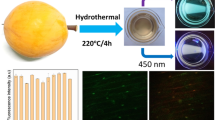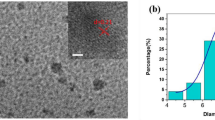Abstract
Carbon dots are a new and important form of zero-dimensional carbonaceous nanomaterials. In our present work, disperse water-soluble fluorescent carbon dots were prepared using coffee grounds as raw material by hydrothermal treatment. The as-prepared carbon dots exhibit an excitation-dependent and high photostable photoluminescence behavior which can be applied to Hela cell imaging. Notably, the fluorescence of the carbon dots can be quenched by Fe3+ ions, which can serve as a useful fluorescent probe for detecting Fe3+ ions.





Similar content being viewed by others

References
Marzin JY, Gérard JM, Izraël A, Barrier D, Bastard G (1994) Photoluminescence of single InAs quantum dots obtained by self-organized growth on GaAs. Phys Rev Lett 73:716–719
Fischer I, Milroy KP, Dorland YL, Schenning APHJ, Brunsveld L (2013) Self-assembled fluorescent organic nanoparticles for live-cell imaging. Chem Eur J 19:16646–16650
Ray SC, Saha A, Jana NR, Sarkar R (2009) Fluorescent carbon nanoparticles: synthesis, characterization, and bioimaging application. J Phys Chem C 113:18546–18551
Baker SN, Baker GA (2010) Luminescent carbon nanodots: emergent nanolights. Angew Chem Int Edit 49:6726–6744
Liu H, Ye T, Mao C (2007) Fluorescent carbon nanoparticles derived from candle soot. Angew Chem Int Edit 46:6473–6475
Dong Y, Wang R, Li H, Shao J, Chi Y, Lin X, Chen G (2012) Polyamine-functionalized carbon quantum dots for chemical sensing. Carbon 50:2810–2815
Zhang X, Pan J, Zhu C, Sheng Y, Yan Z, Wang Y, Feng B (2015) The visible light catalytic properties of carbon quantum dots/ZnO nanoflowers composites. J Mater Sci Mater Electron 26:2861–2866. doi:10.1007/s10854-015-2769-x
Chen J, Liu W, Mao L-H, Yin Y-J, Wang C-F, Chen S (2014) Synthesis of silica-based carbon dot/nanocrystal hybrids toward white LEDs. J Mater Sci 49:7391–7398. doi:10.1007/s10853-014-8413-y
Wei W, Xu C, Ren J, Xu B, Qu X (2012) Sensing metal ions with ion selectivity of a crown ether and fluorescence resonance energy transfer between carbon dots and graphene. Chem Commun 48:1284–1286
Liu Y, Zhao Y, Zhang Y (2016) Synthesis of cellulose-derived carbon dots using acidic ionic liquid as a catalyst and its application for detection of Hg2+. J Mater Sci 51:861–867. doi:10.1007/s10853-015-9410-5
Cao L, Wang X, Meziani MJ, Lu F, Wang H, Luo PG, Lin Y, Harruff BA, Veca LM, Murray D, Xie S-Y, Sun YP (2007) Carbon dots for multiphoton bioimaging. J Am Chem Soc 129:11318–11319
Wang J, Qiu J (2016) A review of carbon dots in biological applications. J Mater Sci 51:4728–4738. doi:10.1007/s10853-016-9797-7
Zheng M, Xie Z, Qu D, Li D, Du P, Jing X, Sun Z (2013) On–off–on florescent carbon dot nanosensor for recognition of Chromium(VI) and ascorbic acid based on the inner filter effect. ACS Appl Mater Interfaces 5:13242–13247
Liu JM, Lin L, Wang XX, Lin SQ, Cai WL, Zhang LH, Zheng ZY (2012) Highly selective and sensitive detection of Cu2+ with lysine enhancing bovine serum albumin modified-carbon dots fluorescent probe. Analyst 137:2637–2642
Gonçalvesa H, Jorge PAS, Fernandes JRA, Silva JCGE (2010) Hg(II) sensing based on functionalized carbon dots obtained by direct laser ablation. Sens Actuators B Chem 145:702–707
Chandra S, Laha D, Pramanik A, Chowdhuri AR, Karmakar P, Sahu SK (2016) Synthesis of highly fluorescent nitrogen and phosphorus doped carbon dots for the detection of Fe3+ ions in cancer cells. Luminescence 31:81–87
Lu W, Qin X, Liu S, Chang G, Zhang Y, Luo Y, Asiri AM, Al-Youbi AO, Sun X (2012) Economical, green synthesis of fluorescent carbon nanoparticles and their use as probes for sensitive and selective detection of mercury(II) ions. Anal Chem 84:5351–5357
Bottini M, Balasubramanian C, Dawson MI, Bergamaschi A, Bellucci S, Mustelin T (2006) Isolation and characterization of fluorescent nanoparticles from pristine and oxidized electric arc-produced single-walled carbon nanotubes. J Phys Chem B 110:831–836
Sun YP, Zhou B, Lin Y, Wang W, Fernando KAS, Pathak P, Meziani MJ, Harruff BA, Wang X, Wang H, Luo PG, Yang H, Kose ME, Chen B, Veca LM, Xie S-Y (2006) Quantum-sized carbon dots for bright and colorful photoluminescence. J Am Chem Soc 128:7756–7757
Hu SL, Niu KY, Sun J, Yang J, Zhao N-Q, Du X-W (2009) One-step synthesis of fluorescent carbon nanoparticles by laser irradiation. J Mater Chem 19:484–488
Zhao QL, Zhang Z-L, Huang B-H, Peng J, Zhang M, Pang D-W (2008) Facile preparation of low cytotoxicity fluorescent carbon nanocrystals by electrooxidation of graphite. Chem Commun 41:5116–5118
Zheng L, Chi Y, Dong Y, Lin J, Wang B (2009) Electrochemiluminescence of water-soluble carbon nanocrystals released electrochemically from graphite. J Am Chem Soc 131:4564–4565
Zhu H, Wang X, Li Y, Wang Z, Yang F, Yang X (2009) Microwave synthesis of fluorescent carbon nanoparticles with electrochemiluminescence properties. Chem Commun 34:5118–5120
Wang X, Qu K, Xu B, Ren J, Qu X (2011) Microwave assisted one-step green synthesis of cell-permeable multicolor photoluminescent carbon dots without surface passivation reagents. J Mater Chem 21:2445–2450
Wei J, Shen J, Zhang X, Guo S, Pan J, Hou X, Zhang H, Wang L, Feng B (2013) Simple one-step synthesis of water-soluble fluorescent carbon dots derived from paper ash. RSC Adv 3:13119–13122
Sahu S, Behera B, Maiti TK, Mohapatra S (2012) Simple one-step synthesis of highly luminescent carbon dots from orange juice: application as excellent bio-imaging agents. Chem Commun 48:8835–8837
Zhu C, Zhai J, Dong S (2012) Bifunctional fluorescent carbon nanodots: green synthesis via soy milk and application as metal-free electrocatalysts for oxygen reduction. Chem Commun 48:9367–9369
Kondamudi N, Mohapatra SK, Misra M (2008) Spent coffee grounds as a versatile source of green energy. J Agric Food Chem 56:11757–11760
Mussatto SI, Machado EMS, Martins S, Teixeira JA (2011) Production, composition, and application of coffee and its industrial residues. Food Bioproc Tech 4:661–672
Butt MS, Sultan MT (2011) Coffee and its consumption: benefits and risks. Crit Rev Food Sci 51:363–373
Hsu P-C, Shih Z-Y, Lee C-H, Chang H-T (2012) Synthesis and analytical applications of photoluminescent carbon nanodots. Green Chem 14:917–920
Zhu S, Meng Q, Wang L, Zhang J, Song Y, Jin H, Zhang K, Sun H, Wang H, Yang B (2013) Highly photoluminescent carbon dots for multicolor patterning, sensors, and bioimaging. Angew Chem Int Edit 52:3953–3957
Qian Z, Ma J, Shan X, Feng H, ShaoL Chen J (2014) Highly luminescent N-doped carbon quantum dots as an effective multifunctional fluorescence sensing platform. Chem Eur J 20:2254–2263
Lai T, Zheng E, Chen L, Wang X, Kong L, You C, Ruan Y, Weng X (2013) Hybrid carbon source for producing nitrogen-doped polymer nanodots: one-pot hydrothermal synthesis, fluorescence enhancement and highly selective detection of Fe(III). Nanoscale 5:8015–8021
Liu S, Tian J, Wang L, Li H, Zhang Y, Sun X (2010) Stable aqueous dispersion of graphene nanosheets: noncovalent functionalization by a polymeric reducing agent and their subsequent decoration with Ag nanoparticles for enzymeless hydrogen peroxide detection. Macromolecules 43:10078–10083
Liu S, Tian J, Wang L, Luo Y, Lu W, Sun X (2011) Self-assembled graphene platelet–glucose oxidase nanostructures for glucose biosensing. Biosens Bioelectron 26:4491–4496
Fleutot S, Dupin J-C, Renaudin G, Martinez H (2011) Intercalation and grafting of benzene derivatives into zinc–aluminum and copper–chromium layered double hydroxide hosts: an XPS monitoring study. Phys Chem Chem Phys 13:17564–17578
Bojdys MJ, Müller J-O, Antonietti M, Thomas A (2008) Ionothermal synthesis of crystalline, condensed, graphitic carbon nitride. Chem Eur J 14:8177–8182
Sevilla M, Fuertes AB (2009) Chemical and structural properties of carbonaceous products obtained by hydrothermal carbonization of saccharides. Chem Eur J 15:195–4203
Li X, Zhang G, Bai X, Sun X, Wang X, Wang X, Dai H (2008) Highly conducting graphene sheets and Langmuir–Blodgett films. Nat Nanotechnol 3:538–542
Eda G, Chhowalla M (2010) Chemically derived graphene oxide: towards large-area thin-film electronics and optoelectronics. Adv Mater 22:2392–2415
Li H, He X, Liu Y, Yu H, Kang Z (2011) Synthesis of fluorescent carbon nanoparticles directly from active carbon via a one-step ultrasonic treatment. Mater Res Bull 46:147–151
Chitre SA, Lobo G-AM, Rathod SM, Smith RB, Leslie R, Livingstone C, Davis J (2008) Bromide–sulfur interchange: ion chromatographic determination of total reduced thiol levels in plasma. J Chromatogr B 864:173–177
Liu R, Wu D, Liu S, Koynov K, Knoll W, Li Q (2009) An aqueous route to multicolor photoluminescent carbon dots using silica spheres as carriers. Angew Chem Int Edit 48:4598–4601
Krysmann MJ, Kelarakis A, Dallas P, Giannelis EP (2012) Formation mechanism of carbogenic nanoparticles with dual photoluminescence emission. J Am Chem Soc 134:747–750
Zhai X, Zhang P, Liu C, Bai T, Li W, Dai L, Liu W (2012) Highly luminescent carbon nanodots by microwave-assisted pyrolysis. Chem Commun 48:7955–7957
Pan D, Zhang J, Li Z, Wu C, Yan C, Wu M (2010) Observation of pH-, solvent-, spin-, and excitation-dependent blue photoluminescence from carbon nanoparticles. Chem Commun 46:3681–3683
Zhang X, Wang S, Xu L, Feng L, Ji Y, Tao L, Li S, Wei Y (2012) Biocompatible polydopamine fluorescent organic nanoparticles: facile preparation and cell imaging. Nanoscale 4:5581–5584
Peng J, Gao W, Gupta BK, Liu Z, Romero-Aburto R, Ge L, Song L, Alemany L, Zhan X, Gao G, Vithayathil SA, Kaipparettu BA, Marti AA, Hayashi T, Zhu J-J, Ajayan PM (2012) Graphene quantum dots derived from carbon fibers. Nano Lett 12:844–849
Ding C, Zhu A, Tian Y (2014) Functional surface engineering of C-dots for fluorescent biosensing and in vivo bioimaging. Acc Chem Res 47:20–30
Li H, Kang Z, Liu Y, Lee S-T (2012) Carbon nanodots: synthesis, properties and applications. J Mater Chem 22:24230–24253
Qu K, Wang J, Ren J, Qu X (2013) Carbon dots prepared by hydrothermal treatment of dopamine as an effective fluorescent sensing platform for the label-free detection of iron(III) ions and dopamine. Chem Eur J 19:7243–7249
Zhao A, Zhao C, Li M, Ren J, Qu X (2014) Ionic liquids as precursors for highly luminescent, surface-different nitrogen-doped carbon dots used for label-free detection of Cu2+/Fe3+ and cell imaging. Anal Chim Acta 809:128–133
Acknowledgements
This work was supported by the National Natural Science Foundation of China (51272098 and 51551201).
Author information
Authors and Affiliations
Corresponding author
Electronic supplementary material
Below is the link to the electronic supplementary material.
Rights and permissions
About this article
Cite this article
Ge, L., Yu, H., Ren, H. et al. Photoluminescence of carbon dots and their applications in Hela cell imaging and Fe3+ ion detection. J Mater Sci 52, 9979–9989 (2017). https://doi.org/10.1007/s10853-017-1178-3
Received:
Accepted:
Published:
Issue Date:
DOI: https://doi.org/10.1007/s10853-017-1178-3



